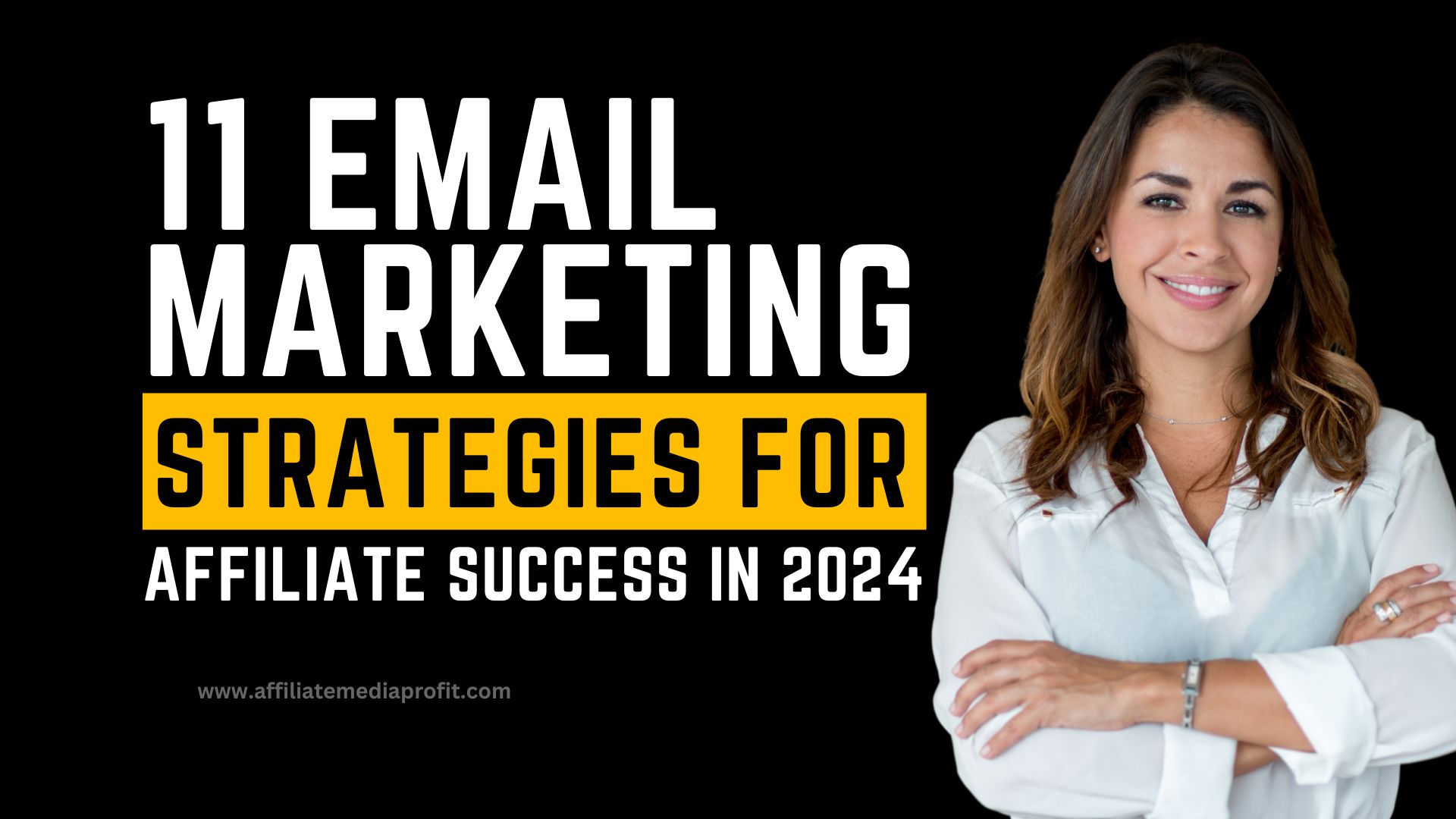Welcome to 11 Email Marketing Strategies for Affiliate Success in 2024! If you’re aiming to boost your affiliate marketing efforts, email marketing is a powerful tool you can’t afford to overlook. This blog will reveal eleven effective email marketing strategies to help you increase your affiliate income in 2024. From crafting compelling subject lines to segmenting your audience and personalizing your content, we’ll cover all the essentials to ensure your email campaigns drive results. Ready to elevate your affiliate marketing game? Let’s dive into these top email marketing strategies!
My Tested Method for Making $100-$300 Daily: FREE Video Guide to START TODAY >>>

Segment your audience and personalize content to boost engagement. Use compelling subject lines and clear calls to action.
Email marketing remains a powerful tool for businesses to connect with their audience. By segmenting your audience, you can tailor messages that resonate with specific groups. Personalized content increases open rates and engagement, making recipients feel valued. Compelling subject lines grab attention, while clear calls to action drive conversions.
Testing different elements, such as send times and email formats, helps optimize performance. Analytics provide insights into what works, allowing for continuous improvement. Automation streamlines the process, ensuring timely and relevant communication. Building a strong email list and maintaining good sender reputation is crucial. Focus on delivering value and maintaining consistency to achieve long-term success in email marketing.
Building An Email List
Email marketing strategies are essential for any business aiming to build a strong online presence. One of the most crucial steps in email marketing is building an email list. A well-curated email list allows you to reach your audience directly and build lasting relationships. This process involves attracting potential subscribers, encouraging them to sign up, and managing their information effectively.
Creating A Lead Magnet
A lead magnet is a valuable resource you offer to potential subscribers in exchange for their email addresses. It should be something your target audience finds irresistible. Here are some effective lead magnet ideas:
- E-books: Write a comprehensive guide on a topic your audience cares about.
- Checklists: Provide a step-by-step list that simplifies a complex process.
- Discounts or Coupons: Offer a special discount to new subscribers.
- Free Trials: Let users try your product for free for a limited time.
Remember to promote your lead magnet across various platforms. Share it on social media, your website, and through collaborations with other businesses. Ensure your lead magnet is easy to download and provides instant value.
Opt-in Forms And Landing Pages
Opt-in forms and landing pages are crucial for capturing email addresses. Your opt-in form should be simple and straightforward. Ask for only essential information, such as name and email address. Place these forms on high-traffic areas of your website.
Create dedicated landing pages for your lead magnet. A landing page is a standalone web page designed to convert visitors into subscribers. Here are some tips for an effective landing page:
- Clear Headline: Your headline should convey the value of your lead magnet.
- Compelling Copy: Write persuasive content that highlights the benefits of subscribing.
- Strong Call-to-Action: Use a clear and enticing call-to-action button.
- Minimal Distractions: Remove any unnecessary elements that could distract visitors.
Test different versions of your opt-in forms and landing pages. A/B testing helps you understand what resonates best with your audience.
My Tested Method for Making $100-$300 Daily: FREE Video Guide to START TODAY >>>
Segmenting Your Email List
Segmenting your email list means dividing your subscribers into smaller groups based on specific criteria. This allows you to send more personalized and relevant emails. Here are some common segmentation criteria:
- Demographics: Age, gender, location, etc.
- Behavior: Purchase history, email engagement, website activity.
- Preferences: Interests, product preferences, communication frequency.
Use segmentation to tailor your email content to each group’s needs and interests. Personalized emails see higher open and click-through rates. For instance, send a special birthday discount to subscribers during their birthday month. Share exclusive content with your most engaged subscribers.
Implementing these strategies will help you build a robust and effective email list. It’s all about providing value, making the sign-up process easy, and personalizing your communication.
Crafting Compelling Emails
Email marketing is a powerful tool for businesses. One of the key components of successful email marketing is crafting compelling emails. Well-crafted emails can engage your audience, increase open rates, and drive conversions. This section will explore some essential strategies for creating captivating emails that your subscribers will love.
Writing Attention-grabbing Subject Lines
Your email’s subject line is the first thing your audience sees. An attention-grabbing subject line can significantly increase open rates. Here are some tips for writing effective subject lines:
- Keep it short and sweet: Aim for 50 characters or less.
- Use action verbs: Words like “Discover,” “Learn,” and “Boost” can create a sense of urgency.
- Personalize when possible: Including the recipient’s name can make the email feel more personal.
- Create curiosity: Pique interest with intriguing phrases or questions.
- Avoid spammy words: Words like “Free,” “Buy now,” and “Urgent” can trigger spam filters.
Consider these examples of effective subject lines:
| Effective Subject Line | Reason |
| Unlock Your Exclusive 20% Discount Today! | Creates urgency and offers a clear benefit |
| John, Your Free Guide to Better Marketing Awaits | Personalizes and offers valuable content |
| 3 Simple Steps to Boost Your Productivity | Promises easy and actionable advice |
Personalizing Your Emails
Personalization can make your emails feel more relevant and engaging. Here are some ways to personalize your emails:
- Use the recipient’s name: Addressing the recipient by name can capture their attention.
- Segment your audience: Group subscribers based on their interests or behaviors.
- Send tailored content: Customize the email content to match the recipient’s preferences.
- Utilize dynamic content: Use dynamic fields to insert personalized information.
Consider this example of a personalized email:
Hello John,
We noticed you enjoyed our recent article on email marketing tips. Here are some more resources we think you’ll love:
– How to Write Compelling Subject Lines
– Personalization Techniques for Higher Engagement
– Engaging Content Ideas for Your Next Campaign
Best regards,
The Marketing Team
Personalized emails can make recipients feel valued and understood, leading to higher engagement rates.
Using Engaging Content
Your email content should be engaging to keep your audience interested. Here are some tips for creating engaging content:
- Use visuals: Images, infographics, and videos can make your emails more appealing.
- Be concise: Keep your content short and to the point.
- Include a clear call to action (CTA): Guide your recipients on what to do next.
- Share valuable information: Provide tips, insights, or exclusive offers.
- Tell a story: Stories can make your content more relatable and memorable.
Here’s an example of engaging email content:
Hi Sarah,
We have exciting news! Our latest product release is here, and we think you’ll love it. Watch the video below to learn more:
[Product Video]
Plus, we’re offering an exclusive discount just for you. Use code WELCOME20 at checkout to save 20%.
Best,
The Product Team
Engaging content can captivate your audience and motivate them to take action, leading to better results from your email marketing campaigns.
Automation And Drip Campaigns
Email marketing strategies have evolved, and automation and drip campaigns stand out. These tools help businesses engage customers effortlessly. By automating emails, you save time and ensure consistent communication. Drip campaigns nurture leads, guiding them through the sales funnel. Both techniques enhance customer experience and drive conversions.
Setting Up Automated Email Sequences
Automated email sequences streamline your marketing efforts. They trigger emails based on user actions. For instance, a welcome email is sent when someone subscribes to your newsletter. Setting up these sequences involves a few steps:
- Choose an Email Marketing Platform: Platforms like Mailchimp or HubSpot offer automation features.
- Define Your Goals: Are you welcoming new subscribers or nurturing existing ones?
- Create Your Email Content: Draft emails that align with your goals.
- Set Triggers: Determine what actions will trigger each email. Examples include sign-ups, purchases, or website visits.
- Test Your Sequence: Ensure each email sends correctly and at the right time.
Here’s a simple table summarizing the steps:
| Step | Description |
| Choose Platform | Select an email marketing tool with automation features. |
| Define Goals | Identify the purpose of your email sequence. |
| Create Content | Write engaging emails for your audience. |
| Set Triggers | Choose actions that will start each email. |
| Test Sequence | Verify timing and content of each email. |
Automated email sequences ensure timely communication. They boost engagement and improve customer experience.
Nurturing Leads With Drip Campaigns
Drip campaigns guide leads through the sales process. They send a series of emails over time. This method keeps your brand top-of-mind. Setting up a drip campaign involves:
- Segmenting Your Audience: Group your leads based on interests or behaviors.
- Mapping Out the Journey: Plan the sequence of emails that will nurture your leads.
- Creating Relevant Content: Tailor your emails to address the needs of each segment.
- Scheduling Emails: Decide when each email will be sent.
- Monitoring Performance: Track open rates and click-through rates to measure success.
Here’s an example of a drip campaign schedule:
| Day | |
| Day 1 | Welcome Email |
| Day 3 | Introduction to Products/Services |
| Day 7 | Customer Testimonials |
| Day 14 | Special Offer |
Effective drip campaigns build trust and encourage leads to take action. They keep your audience engaged without overwhelming them. Consistent communication through drip campaigns increases the likelihood of conversions.
Testing And Optimization
Testing and Optimization in email marketing is crucial for maximizing campaign performance. By systematically testing different elements and analyzing key metrics, marketers can fine-tune their strategies to achieve better results. Whether it’s subject lines, content layout, or call-to-action buttons, understanding what works best for your audience can make a significant difference. This section will delve into three essential aspects: A/B Testing, Analyzing Email Metrics, and Optimizing Email Performance.
A/b Testing Your Email Campaigns
A/B testing, also known as split testing, involves sending two variations of an email to different segments of your audience to see which performs better. This method helps identify which elements resonate most with your subscribers. Here are some key elements to test:
- Subject Lines: Test different lengths, tones, and emojis to see which grabs attention.
- Call-to-Action (CTA) Buttons: Experiment with different colors, text, and placements.
- Email Content: Compare long-form vs. short-form content, and different types of visuals.
- Send Times: Determine the best time and day for higher open rates.
Here’s a simple table to illustrate an A/B test setup:
| Element | Variation A | Variation B |
| Subject Line | “20% Off Sale!” | “Limited Time Offer!” |
| CTA Button | Red, “Shop Now” | Green, “Buy Now” |
Implement A/B testing regularly to keep your email strategy effective and up-to-date. This will provide valuable insights and drive better engagement.
Analyzing Email Metrics
To optimize your email marketing, analyzing key metrics is essential. Important metrics to track include:
- Open Rate: Indicates how many recipients opened your email. A higher open rate often means your subject line was compelling.
- Click-Through Rate (CTR): Measures the percentage of recipients who clicked on a link in your email. A higher CTR indicates engaging content.
- Conversion Rate: Shows the percentage of recipients who completed a desired action, like making a purchase. This metric directly ties to your campaign’s effectiveness.
- Bounce Rate: Represents the percentage of emails that were not delivered. A high bounce rate can signal issues with your email list quality.
- Unsubscribe Rate: Tracks the number of people who opted out of your email list. Keeping this rate low is crucial for maintaining a healthy list.
Regularly monitoring these metrics helps in understanding what works and what needs improvement. Use these insights to refine your strategies for better engagement and conversions.
Optimizing Email Performance
Optimizing email performance involves making data-driven decisions to enhance the effectiveness of your campaigns. Here are some strategies:
- Personalization: Use recipient’s name and tailor content to individual preferences to boost engagement.
- Segmentation: Divide your email list into smaller groups based on demographics or behavior. Send targeted emails for higher relevance.
- Mobile Optimization: Ensure your emails look great on all devices. Use responsive design and concise content for better readability.
- Content Quality: Provide valuable and relevant content. Balance promotional messages with informative and engaging articles.
- Consistent Testing: Continuously A/B test different elements to discover what works best. Adapt based on the results to keep improving.
Regularly apply these strategies to maintain high performance and stay ahead in the competitive landscape of email marketing. By doing so, you can ensure your emails not only reach your audience but also engage and convert them effectively.
Email Design Best Practices
Email Marketing Strategies are vital for reaching out to your audience effectively. One crucial aspect is ensuring your emails are designed well. Good design can increase engagement, click-through rates, and overall campaign success. Let’s dive into some Email Design Best Practices to help you craft compelling and effective emails.
Choosing The Right Email Template
Choosing the right email template is crucial for your campaign’s success. An effective template should be visually appealing and align with your brand. Here are some tips to help you choose the best template:
- Brand Consistency: Ensure your template reflects your brand’s colors, fonts, and style.
- Layout: Opt for a clean and organized layout. Avoid clutter to keep the focus on your message.
- Flexibility: Choose a template that allows easy customization for different campaigns.
Below is a table summarizing different types of email templates and their best uses:
| Email Template Type | Best Use |
| Newsletter | Sharing updates, news, and articles |
| Promotional | Highlighting sales, discounts, and special offers |
| Transactional | Order confirmations, shipping updates |
| Event Invitation | Inviting subscribers to webinars, conferences |
Mobile-friendly Email Design
With more people checking emails on their phones, mobile-friendly design is essential. Here are some best practices:
- Responsive Design: Ensure your email template adjusts to different screen sizes.
- Single-Column Layout: Use a single-column layout for better readability on small screens.
- Large Fonts: Use larger fonts to enhance readability.
- Touch-Friendly Buttons: Ensure buttons are large enough for easy tapping.
Consider these additional tips to improve mobile email design:
- Short Subject Lines: Keep subject lines concise to fit smaller screens.
- Optimized Images: Use compressed images to reduce load time.
- Whitespace: Use ample whitespace to avoid a crowded look.
Including A Clear Call-to-action
A clear Call-to-Action (CTA) is essential for guiding your readers to take the desired action. Here’s how to create effective CTAs:
- Actionable Language: Use verbs like “Buy,” “Sign Up,” or “Learn More.”
- Visibility: Place your CTA in a prominent position.
- Contrasting Colors: Use colors that stand out against your background.
Here are some examples of effective CTA phrases:
- Shop Now
- Register Today
- Get Started
- Download Now
Use these tips to ensure your CTAs drive the desired actions and boost your campaign’s success.
Email Deliverability
Email marketing strategies are crucial for reaching your audience. One key aspect is ensuring your emails reach the inbox, not the spam folder. This is known as Email Deliverability. High deliverability rates mean more people see your messages, increasing engagement and conversions.
My Tested Method for Making $100-$300 Daily: FREE Video Guide to START TODAY >>>
Avoiding Spam Filters
Spam filters are designed to protect users from unwanted emails. To avoid them, follow these tips:
- Use a recognizable sender name: People open emails from names they know.
- Craft a clear subject line: Avoid all caps, excessive punctuation, and spammy words like “free” or “guarantee”.
- Check your content: Balanced text-to-image ratio, minimal links, and proper grammar help avoid spam triggers.
- Authenticate your emails: Use SPF, DKIM, and DMARC records to prove your emails are legitimate.
- Provide an easy unsubscribe option: This reduces spam complaints.
Avoiding spam filters is essential for high email deliverability. Use these strategies to ensure your emails land in the inbox.
Maintaining A Good Sender Reputation
A good sender reputation is vital for high deliverability rates. ISPs use your reputation to decide if your emails are spam. Follow these tips to maintain a good sender reputation:
- Send relevant content: Ensure your emails are useful to your subscribers.
- Get permission: Only email people who have opted in.
- Monitor your metrics: Track bounce rates, open rates, and spam complaints.
- Clean your email list: Remove inactive or invalid email addresses regularly.
- Send emails consistently: Avoid long gaps between emails to stay top-of-mind.
Maintaining a good sender reputation increases your email deliverability. Follow these practices to keep your emails reaching your audience.
Measuring Success And Roi
Email marketing is a powerful tool for reaching your audience. But how do you know it’s working? Measuring success and ROI is crucial. Knowing your metrics helps you optimize campaigns. Let’s dive into the key aspects of measuring success and ROI in email marketing.
Tracking Email Conversions
Tracking email conversions is essential for understanding your campaign’s impact. Conversions can be anything from a purchase to a sign-up. Knowing what actions users take helps you gauge success.
Here are some key metrics to track:
- Open Rate: Percentage of recipients who open your email.
- Click-Through Rate (CTR): Percentage of recipients who click on a link.
- Conversion Rate: Percentage of recipients who complete a desired action.
- Bounce Rate: Percentage of emails that don’t reach the recipient.
- Unsubscribe Rate: Percentage of recipients who unsubscribe.
Use tracking tools to gather data. Google Analytics, for example, offers insights into user behavior. Integrate it with your email platform.
Here’s a sample HTML code for tracking clicks:
Your Link
This code helps you monitor clicks from your emails.
Calculating Return On Investment
Calculating ROI shows the financial return of your campaigns. It’s crucial for budgeting and strategy. Here’s a simple formula:
For example, if you spend $500 on an email campaign and earn $2000 in sales, your ROI is:
| Metric | Value |
| Revenue | $2000 |
| Cost | $500 |
| ROI | (2000 – 500) / 500 = 3.0 or 300% |
A 300% ROI means your campaign is highly effective. Track other costs too, like software and time spent. Use these insights to refine your email marketing strategy.
Frequently Asked Questions
What Are The 7 Email Marketing Strategies?
1. Build a targeted email list. 2. Craft compelling subject lines. 3. Personalize your emails. 4. Segment your audience. 5. Use clear calls-to-action. 6. Optimize for mobile devices. 7. Analyze and improve performance.
What Are The Strategies Of Email Marketing?
Effective email marketing strategies include segmenting your audience, personalizing content, creating compelling subject lines, automating campaigns, and analyzing performance metrics. Regularly update your email list and ensure mobile-friendly design. Focus on delivering value and engaging content to build strong customer relationships.
What Are The 5 Steps Of Email Marketing?
The 5 steps of email marketing are: 1. Build a targeted email list. 2. Create engaging and relevant content. 3. Design visually appealing emails. 4. Test and optimize campaigns. 5. Track performance and analyze results.
What Are The Four Types Of Email Marketing?
The four types of email marketing are: 1. Promotional emails. 2. Informational emails. 3. Transactional emails. 4. Re-engagement emails. These types help businesses engage with their audience effectively.
Conclusion
Mastering email marketing strategies can transform your business. Focus on personalization and engaging content. Track your results and adjust accordingly. Keep your audience’s needs at the forefront. With these steps, you’ll boost your open rates and conversions, driving success. Start refining your email campaigns today and see the difference.
My Tested Method for Making $100-$300 Daily: FREE Video Guide to START TODAY >>>
Thank you for reading my blog 11 Email Marketing Strategies for Affiliate Success in 2024. With these strategies, you’re now equipped to harness the power of email marketing and achieve greater success in your affiliate marketing endeavors. Start implementing these tips today and watch your affiliate income grow. Here’s to your success in email marketing for affiliate success in 2024!









